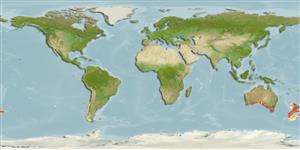Environment: milieu / climate zone / depth range / distribution range
Ecologie
marien; brak water benthopelagisch; oceanodroom (Ref. 51243); diepte 27 - 650 m (Ref. 58489). Temperate; 32°S - 55°S, 115°E - 71°W
Eastern Indian Ocean: southern Australia (from South Australia to New South Wales and Tasmania). Southwest Pacific: New Zealand and Kermadec Island. Southeast Pacific: Chile (Ref. 9068).
Lengte bij maturiteit / Grootte / Gewicht / Leeftijd
Maturity: Lm 40.0 range ? - ? cm
Max length : 66.0 cm TL mannelijk / geslacht onbekend; (Ref. 9563); common length : 51.0 cm FL mannelijk / geslacht onbekend; (Ref. 9049); max. gerapporteerde leeftijd: 15 Jaren (Ref. 9072)
Adults are usually demersal on the continental shelf and slope, occasionally occurring at the surface; subadults in surface waters, sometimes entering bays, while juveniles occur offshore (Ref. 9563). Reported from depths of 27 m (Ref. 58489) to 600 m (Ref. 9563). They form feeding and spawning aggregations. Spotted warehou are schooling species, usually aggregating close to the sea bed (Ref. 26498) although there is some evidence that they move into the middle water column at night (Ref. 30459). During spring-summer in New Zealand, adult and juvenile fish migrate to feed along the continental slope off the east and southeast coast of the South Island (Ref. 9072). Adults mainly eat planktonic tunicates (Ref. 6390).
In New Zealand, spotted warehou are thought to undertake a southerly migration following spawning on the Chatham Rise in spring (Ref. 26998).
Paulin, C., A. Stewart, C. Roberts and P. McMillan, 1989. New Zealand fish: a complete guide. National Museum of New Zealand Miscellaneous Series No. 19. 279 p. (Ref. 5755)
Status op de Rode Lijst van het IUCN (Ref. 130435)
Gevaar voor de mens
Harmless
Gebruik door de mens
Visserij: commercieel
Tools
Speciale rapporten
Download XML
Internetbronnen
Estimates based on models
Preferred temperature (Ref.
123201): 9.7 - 15.4, mean 13 °C (based on 84 cells).
Fylogenetische diversiteitsindex (Ref.
82804): PD
50 = 0.5156 [Uniqueness, from 0.5 = low to 2.0 = high].
Bayesian length-weight: a=0.00955 (0.00485 - 0.01879), b=3.13 (2.95 - 3.31), in cm total length, based on LWR estimates for this species & (Sub)family-body (Ref.
93245).
Trofisch niveau (Ref.
69278): 3.5 ±0.41 se; based on food items.
Weerstandsvermogen (Ref.
120179): Gemiddeld, minimale populatieverdubbelingstijd 1,4-4,4 jaar (K=0.36; tm=3-4; tmax=15).
Prior r = 0.70, 95% CL = 0.46 - 1.05, Based on 2 stock assessments.
Fishing Vulnerability (Ref.
59153): Low to moderate vulnerability (33 of 100).
Climate Vulnerability (Ref.
125649): High to very high vulnerability (74 of 100).
Nutrients (Ref.
124155): Calcium = 21.4 [14.6, 40.2] mg/100g; Iron = 0.316 [0.197, 0.529] mg/100g; Protein = 17.6 [15.7, 19.5] %; Omega3 = 0.733 [0.427, 1.296] g/100g; Selenium = 22.4 [10.3, 42.4] μg/100g; VitaminA = 17.7 [6.7, 50.1] μg/100g; Zinc = 0.534 [0.400, 0.715] mg/100g (wet weight); based on
nutrient studies.
